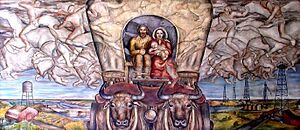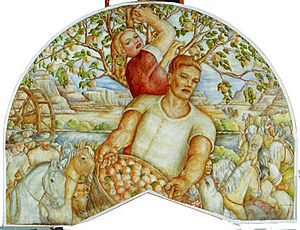Louise Emerson Ronnebeck facts for kids
Louise Emerson Ronnebeck (born August 25, 1901 – died February 17, 1980) was an American artist. She is best known for her amazing murals. During the tough times of the Great Depression, she entered many art contests for the government's Works Progress Administration (WPA). She won two big projects and completed them. Louise created many large wall paintings called frescoes, as well as smaller paintings on easels. Sadly, not many of her artworks are still around today.
Born in Philadelphia, Pennsylvania, Louise grew up in New York City. In 1926, she married another artist, Arnold Rönnebeck. They moved to Denver, Colorado. In Denver and later in Bermuda, she became a successful artist and teacher. Through her art in the 1930s and 1940s, she showed important moments from American history and social issues, especially in the western United States.
Contents
Early Life and Art Studies
Mary Louise Harrington Emerson was born in 1901 in Philadelphia. She was the third daughter of Mary Crawford Suplee and Harrington Emerson. Her father was an "efficiency engineer," which meant he helped businesses work better and faster. Louise's great-grandfather, Samuel D. Ingham, was even a very important person in the government. He was the United States Secretary of the Treasury (like the head of the country's money department) under President Andrew Jackson.
In 1922, Louise graduated from Barnard College. She then spent three years studying art at the Art Students League of New York. One of her teachers was Kenneth Hayes Miller. He was a big influence on American art, especially a style called "American scene painting" and "social realist art." These styles focused on showing everyday life and social issues. Louise really liked Miller's realistic style and how he used tempera paint.
In 1923 and 1924, Louise spent her summers in France. She studied fresco painting, which is a way of painting directly onto wet plaster walls. This skill would become very important in her career.
Married Life and Family
Louise Emerson met Arnold Rönnebeck in 1925. They were both visiting the home of Mabel Dodge Luhan, a famous writer, in Taos, New Mexico. They got married on March 18, 1926, in New York City. Mabel and her husband, Tony Luhan, who was a Native American, attended the wedding. Tony wore his traditional Indian clothes. Louise was happy they were there because Mabel and Tony had helped her and Arnold get together. But, it's said that Louise joked, "When everyone filed into the church, no one paid any attention to the bride because there was this American Indian sitting there with the ceremonial ribbons in his braids!"
After their wedding, Arnold and Louise went on a long trip through the western United States. Arnold worked on art projects along the way. They finally settled in Denver, Colorado. Arnold became the director of the Denver Art Museum. The couple also helped start the Denver Artists Guild, a group for local artists. Louise continued to use her maiden name, Emerson, for her art until about 1931. After that, she started signing her paintings "Louise Emerson Ronnebeck" or "Louise Ronnebeck."
Louise and Arnold had two children: Arnold, born in 1927, and Ursula, born in 1929. Louise often painted scenes from her daily life. Her children, their friends, and even their teachers sometimes posed for her paintings. She also painted local events that showed the lives of women in the area. For example, she painted a courtroom scene about a young woman who was accused of a crime. This painting, called The people vs. Mary Elizabeth Smith, showed how well Louise could tell a story through her art.
WPA Murals: Art for Everyone
During the Great Depression, many people struggled to find work. The government created programs to help, including the Works Progress Administration (WPA). This program also supported artists. Louise actively looked for art projects by sending her ideas to a government art group called the Section of Fine Arts. This group focused on creating art for federal buildings, like post offices.
Some people wondered if art was important when so many were suffering. But Harry Hopkins, who led the WPA, famously said about artists, "Hell! They've got to eat just like other people!" Many worried that if the Depression lasted too long, a whole generation of artists would be lost, and American culture would suffer.
Between 1937 and 1944, Louise entered 16 competitions for mural projects. She won two important commissions for post office murals. These were paid for by the government's Section of Painting and Sculpture.
Louise's first mural was called The Fertile Land Remembers. It was a large oil painting, about 10 feet by 5 feet. It was made for the post office in Worland, Wyoming, and put up in 1938. There was a small debate because a Colorado artist was chosen for a Wyoming mural. But the art director said that Wyoming artists had a fair chance to compete.
To prepare for the mural, Louise researched Wyoming's history and talked to the Worland postmaster. Her approved design showed a determined pioneer family in a covered wagon pulled by oxen, moving towards the viewer. In the background, you can see Native Americans on horses chasing buffalo, painted in a soft, cloud-like way. Both the Native Americans and the pioneer family depended on the land. The mural showed how they were being replaced by the new, growing oil industry. This mural has since been moved to the Casper, Wyoming Post Office.
Louise's second mural was for the post office in Grand Junction, Colorado. This mural, called The Harvest, was installed in 1940. It shows a young man and woman working together to pick peaches. In the background, there's a water wheel. This symbolizes how irrigation (bringing water to dry land) made the land rich and fertile.
This mural shows a common idea from that time: people working together as equals. The man and woman are strong and working towards a shared goal. The mural also shows the Ute Native Americans leaving the valley on the right side, as white settlers arrive from the left. This theme of people being displaced was powerful and showed the changes happening in the American West. Louise's use of family, work, and local landscapes reflected popular art themes of the 1930s.
The Harvest mural had a bit of a mysterious journey! By 1973, it was dirty and dull. It was sent away for cleaning but then got lost for many years. No one knew where it was until 1991! A building manager in Grand Junction kept hearing about the mural and finally found it in New York. It was cleaned and brought back to Grand Junction. In 1992, Louise's son and daughter, who had posed for the mural over 50 years earlier, helped unveil it in a special ceremony. It is still there today.
Art in Denver
Louise loved painting frescoes, which are murals painted directly onto wet plaster. Besides her government murals, she created many frescoes and murals in the Denver area. She painted for places like the Kent School for Girls (1933), Morey Junior High School (1934), and the City and County Building (1935). Sadly, because frescoes are part of the building, many of her murals were lost when buildings were torn down.
Her shortest-lived mural was called The Nativity. It was painted on canvas and put on the front of the City and County Building. It was only meant to be up for the Christmas season of 1935. The mural was 76 feet long! She finished it with two helpers in just two weeks. It was painted in pieces in a basement and took three days to put up.
In 1942, during World War II, the Denver Defense Council asked people to volunteer their skills. Louise volunteered to paint a mural for Denver's new USO Center, which was a place for soldiers. She spent three months, eight hours a day, painting a mural that showed peaceful activities from the 26 countries fighting in the war. For this hard work, the Governor of Colorado named her the civilian "Hero of the Week."
Later Years and Legacy
In 1945, Louise joined the faculty at the University of Denver's School of Art & Art History. She was an Assistant Professor of Drawing and Painting until 1950. Her husband, Arnold Rönnebeck, passed away in 1947. Her last public mural in Colorado was an abstract fresco for a hospital in Greeley, Colorado, in 1952.
In 1954, after both of her children were married, Louise moved to Bermuda. She taught art at the Bermuda High School for Girls from 1955 to 1959. Her very last mural was for St. Brendan's Hospital in 1966. Unfortunately, this mural was destroyed in the 1980s when the hospital was renovated.
In 1973, Louise left Bermuda and returned to Denver. She lived there until she passed away in 1980.



